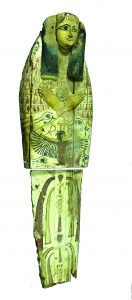×


We have detected your country as:
Please click here to go to the USA website or select another country from the dropdown list.
 Two covers of ancient Egyptian sarcophagi were recently seized by inspectors of the Israel Antiquities Authority (IAA) Unit for the Prevention of Antiquities Robbery, while checking shops in the market place of Jerusalem’s Old City.
Two covers of ancient Egyptian sarcophagi were recently seized by inspectors of the Israel Antiquities Authority (IAA) Unit for the Prevention of Antiquities Robbery, while checking shops in the market place of Jerusalem’s Old City.
The sarcophagi covers are made of wood and coated with a layer of plaster and are ornamented with decorations and paintings of Egyptian hieroglyphics. The objects have been taken for examination on the suspicion they might be stolen property.
It is suspected that Egyptian antiquities robbers plundered ancient tombs in the region of the Western Desert in Egypt, and the covers were then smuggled from Egypt to Dubai. From there they found their way to Israel by way of a third country in Europe. The covers were sawn into two parts, which caused irreparable damage to the ancient items. This was presumably done to reduce their dimensions and facilitate concealing and transporting them in a standard size suitcase. Covers of this kind usually enclosed a sarcophagus made of palm wood about two meters [6.5 ft] long, containing the embalmed remains of the person. It is not known what happened to the mummy and the sarcophagus.
Expert examination and Carbon 14 dating analysis of the wood determined the authenticity of the objects, placing one of them in the period between the 10th and 8th centuries BC (Iron Age) and the other, between the 16th and 14th centuries BC (Late Bronze Age). The artifacts are being held by the IAA under climate-controlled conditions, in their laboratories in Jerusalem.
Recently Egyptian authorities submitted a request asking that the stolen sarcophagi covers be returned to Egypt. The Egyptian request is being taken under advisement by the IAA, in cooperation with the Israel Police and Ministry of Foreign Affairs, and the legalities are currently being examined in order to return the objects to their country of origin.
Source: Excerpts of an article by Edgar Asher, Ashernet
Photo Credit: Ashernet and IAA
All logos and trademarks in this site are property of their respective owner. All other materials are property of Bridges for Peace. Copyright © 2024.
Website Site Design by J-Town Internet Services Ltd. - Based in Jerusalem and Serving the World.